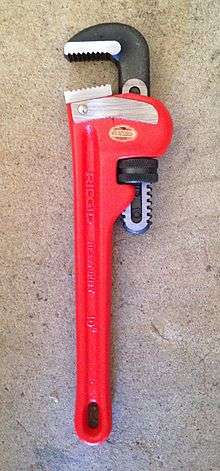Pipe wrench
 A modern pipe wrench. | |
| Classification | hand tool |
|---|---|
| Related | wrench, plumber wrench, monkey wrench |
A pipe wrench is any of several types of wrench that are designed to turn threaded pipe and pipe fittings for assembly (tightening) or disassembly (loosening). Especially in North America, the Stillson wrench or Stillson-pattern wrench is the usual form of pipe wrench. (The name comes from the original patent holder, who licensed the pattern to multiple manufacturers; the patent expired decades ago.) Another type of wrench often used on pipes, the plumber wrench, is also often called a pipe wrench, depending on locale.
The Stillson type is an adjustable wrench/spanner with hardened serrated teeth on its jaws; the hard teeth bite into the softer metal of the round pipe enough to grip it for turning even against fair resistance. The design of the adjustable jaw, with a certain amount of intentional play out of square, allows it to lock in the frame and bind on the pipe, such that any forward pressure on the handle tends to pull the jaws tighter together. Two leaf springs, above and below the knurled knob, help to unlock the jaw on each backstroke.
Pipe wrenches are not intended for regular use on hex nuts or other fittings; however, if a hex nut becomes rounded (stripped) with standard wrenches, a pipe wrench is sometimes used to break the bolt or nut free, because the pipe wrench's specialty of biting into rounded metal surfaces naturally lends itself to this task.
Pipe wrenches are classified by the length of the handle; they can be available in any size from as small as 3 inches up to 48 inches or larger. They are usually made of cast steel. Today, aluminium is also used to construct the body of the wrench, while the teeth and jaw remain steel. Teeth, and jaw kits (which also contain adjustment rings and springs) can be bought to repair broken wrenches, as this can be cheaper than buying a new wrench; which is to say, repairing a high-quality wrench can be more economical (in total cost of ownership for a tradesperson who uses it a lot) than either buying a new high-quality wrench or buying cheap wrenches repeatedly.
History

Daniel C. Stillson (1826-1899), a mechanic at the Walworth Company, in Cambridge, Massachusetts, created the first such wrench.[1] On October 12, 1869, U.S. patent #95,744 was issued to Stillson.[2]
On 17 August 1888 the Swedish inventor Johan Petter Johansson (1853-1943) took his first patent on the adjustable pipe wrench.[3] The Swedish Patent Office issued the patent (SE 5636) again in 1894. The idea emerged after he established his company Enköpings Mekaniska Verkstad. Back then, nut dimensions were poorly standardized, so each time a tradesman was out on a job, he needed a trolley to take a whole set of fixed pipe wrenches with him. Johan Petter Johansson invented a tool that could grip nuts of different dimensions.[4]
Pipe wrench in different countries
In South Africa, the terms "bobbejaan spanner" and "baboon spanner" are commonly used,[5] especially for large pipe wrenches. "Bobbejaan" is the Afrikaans term for a baboon. In Zimbabwe it was usually known by an Anglicized version of the Afrikaans name, "bobbiejohn spanner".
In the United Kingdom these wrenches are often described by their size, i.e. 18" wrenches are known as "18s", or by the general name of "Stillies/stills". In Northern Mexico [Baja California and Sonora]these wrenches are known as stillson.
In popular culture
The pipe wrench is a famous melee weapon in BioShock and many other video games.
See also
- Adjustable spanner
- Monkey wrench—the term is sometimes used loosely for pipe wrench among non-tradespeople, but tradespeople (plumbers, pipefitters) usually speak more precisely than that
- Nipple wrench, a pipe wrench that grabs the interior
- Plumber wrench
- Footprint Tools
References
- ↑ The great workshop: Boston's Victorian Age. Arcadia Publishing.
- ↑ "IMPROVEMENT IN WRENCH". United States Patent and Trademark Office.
- ↑ Bahco
- ↑ Svenska uppfinnare, Petter Karlsson and Johan Erséus, 2003, Sweden
- ↑ South African Concise Oxford Dictionary 2002 p124